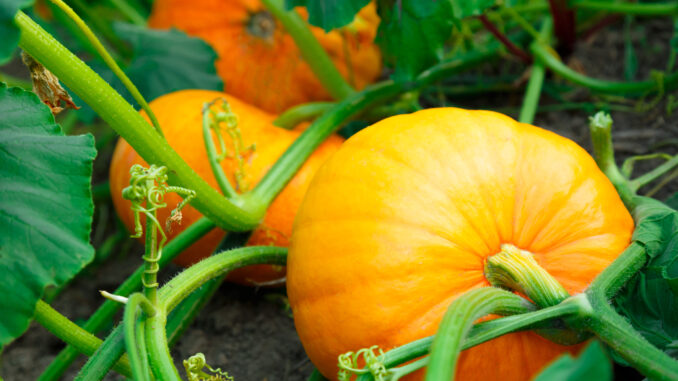

by Bryan Fischer, Curator, and Horticulturist, Gardens on Spring Creek
America has a pumpkin obsession. Our stores fill with decorative ceramic, plastic, and paper pumpkins months before October. We buy or grow and place the real deal with plenty of time for neighborhood squirrels to feed like hogs in our front porch’s very own “orange corral”. We even buy candles and drinks flavored like the stuff. I find this quite interesting since many of my ancestors wouldn’t have even known what a pumpkin was.
Instead, families like mine a few hundred years ago weren’t carving pumpkins, but rather turnips, to ward off malevolent beings on the 31st of the month. That’s because the plant species that is the pumpkin was one of the first crops domesticated anywhere, with evidence of domestication appearing almost 10,000 years ago in Mesoamerica. My ancestors arrived here from Europe one-to-two hundred years ago, long after such crucial work on this crop was done. Digging a face into an off-white, pithy, spicy-scented lump doesn’t sound nearly as satisfying as a gigantic, hollow orange gourd, so I’m thankful to have been introduced, even if a bit late to the (dinner) party.
Actually a type of winter squash, it’s likely the pumpkin would have been grown as part of a “three sisters” intercropping. In such an arrangement, the long-storing winter squash would have been planted with two other crops domesticated in Mesoamerica a few thousand years after squash: corn and dry beans. In addition to producing long-storing dietary staples, each of these plants served other purposes in this arrangement. At their most basic, squash shaded the soil, suppressing weeds and reducing evaporation of water; beans fixed nitrogen, helping to maintain soil fertility; and corn provided a scaffold upon which the bean’s long vines could grow.
Considering this, it becomes clear that pumpkin represents just one slice of the very big – and tasty – pie that is a food crop domesticated by indigenous people of the Americas. Tomato, tomatillo, and chili were domesticated and widely grown only a short time after the above three sisters’ crops, which creates a pretty dire situation for Italian pasta sauce prior to 1492. Interestingly, all these plants, along with avocado and chocolate, share a common language origin, as their English names come from Nahuatl (the principal Aztec language) by way of Spanish. It feels appropriate that those who were among the first to grow these crops would have a cultural legacy that extends beyond just the use of the crop and into the language surrounding it, too.
Thought of less frequently, a few food plants trace their roots to what is now the continental United States. Perhaps most easily seen on the Front Range, the sunflower was domesticated around 4,000 years ago by indigenous agricultural societies in the area around the middle Mississippi River drainage, along with a number of other seed crops. Interestingly, the first people in this region also domesticated squash and gourds in the Cucurbita pepo species independently of those who domesticated the species in Mesoamerica; clearly, it was a very useful plant!
So, as pumpkins roll in this year in their typical orange stampede, consider their origin and those who put in a heck of a lot of work to breed them into a viable crop while enjoying the season. And, as they appear in your cupholder, on your socks, or as a squirrel smorgasbord on the porch, remember that the pumpkin, if your family has roots like mine, is a heck of a lot more fun to carve than a turnip.
Support Northern Colorado Journalism
Show your support for North Forty News by helping us produce more content. It's a kind and simple gesture that will help us continue to bring more content to you.
BONUS - Donors get a link in their receipt to sign up for our once-per-week instant text messaging alert. Get your e-copy of North Forty News the moment it is released!
Click to Donate
